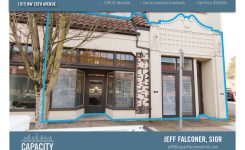Company, Consulting, Industrial, Investments, Office, Retail
Read the fine print
January 16, 2020 - Company, Consulting, Industrial, Investments, Office, Retail
The recent fire at Macadam Center, is an important reminder to understand your rights as a Tenant or a Landlord. It is our privilege to share an article written by Coni Rathbone of Rathbone Law PC about the need to understand your legal rights in the event of a disaster. In this article, she describes a couple of real life scenarios that will inspire you to read and understand your leases, policies to be sure you’re ready when disaster strikes.
Sitting alone in your office or your home reading this article, raise your hand high if you have ever signed an insurance contract, lease, purchase and sale agreement, trust deed, or other contract without reading it cover to cover? Most of you are waiving your arm in the air; me too. However, the best advice I can give you to aid in your preparation for disasters is: “Don’t Do That”! In all seriousness, preparing for your next emergency may be as simple as understanding the rights and responsibilities your lawyers and other professionals have incorporated into your contracts and insurance policies.
“Can your company operate without your space? Consider this for a law firm vs. a manufacturing facility. Most lawyers can work from home, but not someone who is assembling automobiles.”
Every one of your contracts have damage and destruction provisions to govern what, who, why, how and when. For example, your loan documents, likely give the lender control of your insurance proceeds: so “what” a fire that destroys your business premises; “who” your Lender receives the proceeds from insurance; “why” because the lender had more leverage in your loan negotiations; “how” by direct payment from your insurer; and “when” whenever the insurer gets done fighting about their coverage obligations. What does your business do during this period of time, and if the worst happens and the Lender decides to apply the insurance proceeds to pay off your loan balance rather than repairing your premises. It is critical for you to understand this result prior to the casualty not during or after.
One of the most important of your contracts to understand is your own insurance contracts. Insurance policies are hard to read and understand, so you should review them with your insurance professionals. Carefully evaluate all covered risks and all exclusions in your policy, and always give notice of a disaster to your insurance company even if you think it may be excluded. For example, if there is damage caused by an earthquake, and you have an earthquake exclusion, you may still be covered if the earthquake was not the “single proximate cause” of the damage. Losses that may still be covered include property damage, business interruption, ingress and egress, service interruption, defense, claim preparation and moving and hauling. Also, evaluate your various deductibles.
“Losses that may still be covered include property damage, business interruption, ingress and egress, service interruption, defense, claim preparation and moving and hauling.”
Let’s look at business interruption insurance. That is the insurance tenants and others purchase to cover the downtime to a business during a casualty. This intersects with your lease provisions. If you have adequate business interruption you may not need rent abatement in the event of a disaster. In the 1994 Northridge earthquake caused $6.5B in business interruption losses and $44B in property damage. Can your company operate without your space? Consider this for a law firm vs. a manufacturing facility. Most lawyers can work from home, but not someone who is assembling automobiles. Interruption issue may become less important for some companies in a world stored in the cloud. However, storing in the cloud makes a cyber casualty even scarier.
A couple of exemplary insurance provisions are co-insurance and sublimits. Co-insurance is a limitation on the loss recovery available if the limit of insurance purchased by the insured is not at least equal to 80% or another percent of the value of the insured property. This is a penalty applied in the event the amount of insurance you purchased is inadequate for your property. Seems inequitable that you couldn’t receive 100% of your insured amount. Another potentially unexpected limit is sublimits. This is a special limit on coverage for a specific type of loss. You have a policy limit for $1m, however, within the policy is a sublimit of $10k per policy term for cosmetic and aesthetic damages to floors.
“Can your company operate without your space? Consider this for a law firm vs. a manufacturing facility. Most lawyers can work from home, but not someone who is assembling automobiles.”
These are but a few examples of topics for you to evaluate in preparation for your next disaster. It is not a question of if, but when, that disaster will occur. Read the contracts that apply to your life and business. Address with insurance or otherwise the gaps or responsibilities in your contracts. Understand your insurance policies. When an event occurs, big or small; review your policies, confirm the evidence of loss, including photos, videos, evidence. Adhere to any applicable notice provisions in policies, and don’t assume things are not covered. Document your loss by making sure to maintain proof of business performance prior to the loss, during and after.
If reading this articles caused 5% of those hands to go down to my original question, my job is done!
 Coni Rathbone, Esquire, CRE is a remarkable negotiator and dealmaker with years of management and financing experience. She utilizes her negotiation skills to accomplish her clients’ goals with a minimum of conflict.
Coni Rathbone, Esquire, CRE is a remarkable negotiator and dealmaker with years of management and financing experience. She utilizes her negotiation skills to accomplish her clients’ goals with a minimum of conflict.
For more information on getting Landlord or Tenant Representation, you can learn more about our people here.









